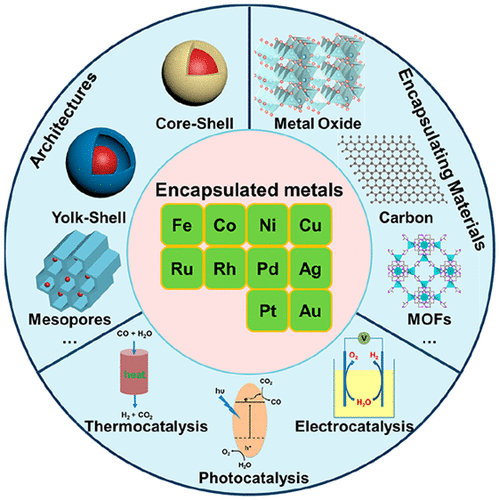当前位置:
X-MOL 学术
›
Chem. Rev.
›
论文详情
Our official English website, www.x-mol.net, welcomes your
feedback! (Note: you will need to create a separate account there.)
Encapsulated Metal Nanoparticles for Catalysis
Chemical Reviews ( IF 51.4 ) Pub Date : 2020-06-25 , DOI: 10.1021/acs.chemrev.0c00237 Chuanbo Gao 1 , Fenglei Lyu 2 , Yadong Yin 3
Chemical Reviews ( IF 51.4 ) Pub Date : 2020-06-25 , DOI: 10.1021/acs.chemrev.0c00237 Chuanbo Gao 1 , Fenglei Lyu 2 , Yadong Yin 3
Affiliation

|
Metal nanoparticles have drawn great attention in heterogeneous catalysis. One challenge is that they are easily deactivated by migration-coalescence during the catalysis process because of their high surface energy. With the rapid development of nanoscience, encapsulating metal nanoparticles in nanoshells or nanopores becomes one of the most promising strategies to overcome the stability issue of the metal nanoparticles. Besides, the activity and selectivity could be simultaneously enhanced by taking advantage of the synergy between the metal nanoparticles and the encapsulating materials as well as the molecular sieving property of the encapsulating materials. In this review, we provide a comprehensive summary of the recent progress in the synthesis and catalytic properties of the encapsulated metal nanoparticles. This review begins with an introduction to the synthetic strategies for encapsulating metal nanoparticles with different architectures developed to date, including their encapsulation in nanoshells of inorganic oxides and carbon, porous materials (zeolites, metal–organic frameworks, and covalent organic frameworks), and organic capsules (dendrimers and organic cages). The advantages of the encapsulated metal nanoparticles are then discussed, such as enhanced stability and recyclability, improved selectivity, strong metal–support interactions, and the capability of enabling tandem catalysis, followed by the introduction of some representative applications of the encapsulated metal nanoparticles in thermo-, photo-, and electrocatalysis. At the end of this review, we discuss the remaining challenges associated with the encapsulated metal nanoparticles and provide our perspectives on the future development of the field.
中文翻译:

封装的金属纳米颗粒用于催化
金属纳米颗粒在非均相催化中引起了极大的关注。一个挑战是由于它们的高表面能,它们在催化过程中很容易因迁移-聚结而失活。随着纳米科学的迅速发展,将金属纳米颗粒封装在纳米壳或纳米孔中成为克服金属纳米颗粒稳定性问题的最有希望的策略之一。此外,通过利用金属纳米颗粒与包封材料之间的协同作用以及包封材料的分子筛性质,可以同时提高活性和选择性。在这篇综述中,我们提供了对封装金属纳米颗粒的合成和催化性能的最新进展的全面总结。这篇综述首先介绍了用于合成具有不同结构的金属纳米颗粒的合成策略,这些策略包括将其封装在无机氧化物和碳的纳米壳,多孔材料(沸石,金属-有机骨架和共价有机骨架)以及有机材料中胶囊(树状聚合物和有机笼)。然后讨论了封装的金属纳米颗粒的优势,例如增强的稳定性和可回收性,改进的选择性,强大的金属-载体相互作用以及实现串联催化的能力,然后介绍了封装的金属纳米颗粒在热学中的一些代表性应用。 -,光催化和电催化。在此评论的末尾,
更新日期:2020-06-25
中文翻译:

封装的金属纳米颗粒用于催化
金属纳米颗粒在非均相催化中引起了极大的关注。一个挑战是由于它们的高表面能,它们在催化过程中很容易因迁移-聚结而失活。随着纳米科学的迅速发展,将金属纳米颗粒封装在纳米壳或纳米孔中成为克服金属纳米颗粒稳定性问题的最有希望的策略之一。此外,通过利用金属纳米颗粒与包封材料之间的协同作用以及包封材料的分子筛性质,可以同时提高活性和选择性。在这篇综述中,我们提供了对封装金属纳米颗粒的合成和催化性能的最新进展的全面总结。这篇综述首先介绍了用于合成具有不同结构的金属纳米颗粒的合成策略,这些策略包括将其封装在无机氧化物和碳的纳米壳,多孔材料(沸石,金属-有机骨架和共价有机骨架)以及有机材料中胶囊(树状聚合物和有机笼)。然后讨论了封装的金属纳米颗粒的优势,例如增强的稳定性和可回收性,改进的选择性,强大的金属-载体相互作用以及实现串联催化的能力,然后介绍了封装的金属纳米颗粒在热学中的一些代表性应用。 -,光催化和电催化。在此评论的末尾,











































 京公网安备 11010802027423号
京公网安备 11010802027423号